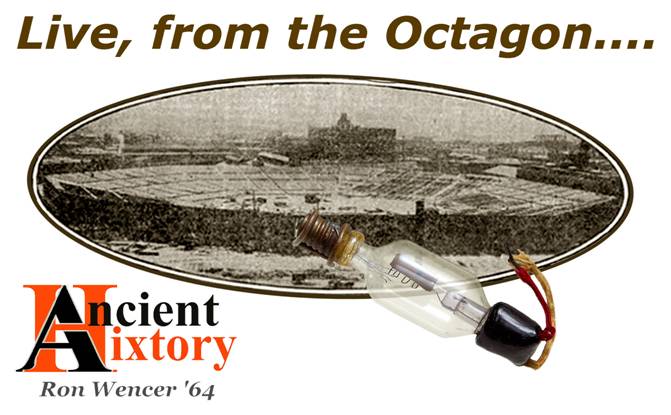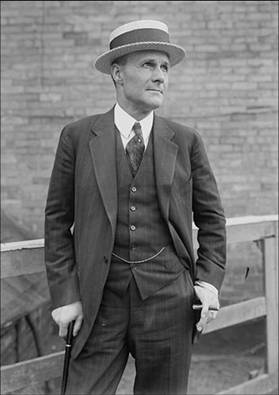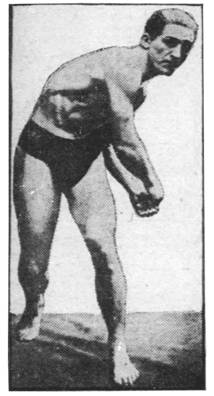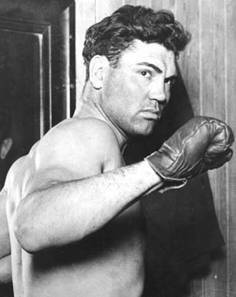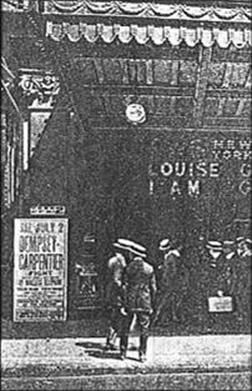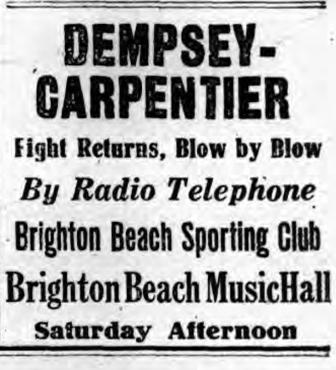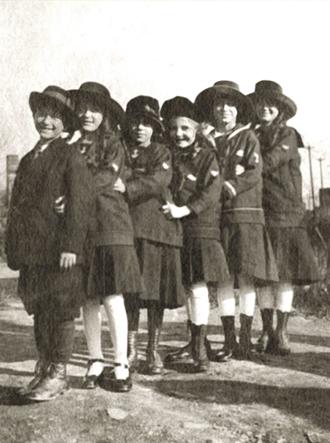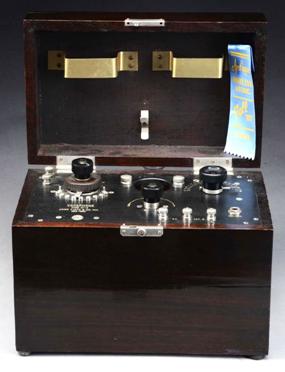In 1921, when my mother was thirteen, there was only one licensed
radio station in the
We tend to think of
inventing as a process that culminates in clear-cut change.
Radio's story was
different, because after being created, radio still had such a long way
to go. In the decades
leading up to World War I, it achieved success only as a form of
wireless telegraphy, relying on "spark-gap" technology (almost as
primitive as it sounds). Spark-gap
radio waves are incapable of carrying audio signals.
It would take many more inventions and inventors before
audio-friendly radio waves existed.
Remarkably, what it did not take was many more decades.
As the 1920s approached, radio engineers in the
Americans had been hearing about radio - at least what they thought was radio - for almost thirty years. By now, the word radio triggered mental images of a guy with earphones on his head, and with one hand glued to a telegraph key, and that image didn't excite them very much. Whatever else they had been told about radio had not impressed them. They were skeptical that radio could improve their lives, and they were too used to what they already had. People read a lot then -
books, magazines, and newspapers. The
papers actually were marvelous in terms of providing the latest news.
They received constant feeds from national and international news
wire services; many papers printed both morning and evening editions, so
that they could deliver the latest information to their customers.
They delivered other things, too: short stories, mysteries in
serial form, special columns for crafters and hobbyists, and most
important of all, the comics.
Trying to overcome this
inertia through technology led to frustration and multiple circular
arguments, such as No one manufactured receivers, because the public did not want
them.
Thus far, in discussing
what might be called "radio for the masses," this article has
ignored radio enthusiasts and amateur radio operators, people whose
story arc was quite different. In
some ways, these people were the forerunners of 1990s computer nerds.
They were unafraid to build or modify assemblies of parts.
They wanted to converse and bond, not just listen.
They wanted to understand how things worked, and to try out new
ideas. And they were happy
to communicate by using a code.
Although the world of
amateur radio operators was distinct from the world of those who wanted
only to listen to commercial radio, as a group, these enthusiasts would
play many important roles, as well as one truly essential one, in
kick-starting commercial radio.
Thanks to enthusiasts, and
even to people who were only on the fringes of "radio enthusiasm,"
there were many "crystal radios" scattered across the country. Student-made crystal
radios have been featured in many entry-level science fair exhibits.
In concept, it seems magical to simply combine a crystal, some
wire, and not much else, and then snatch voices and music from the air.
In continued practice, on the other hand, the magic may wear
thin, as one yearns for better sound quality, and a more useful range of
volume. But a crystal radio
can be, and at times has been, good enough.
If you wanted to do a one-time broadcast to a public who had
never heard radio at all, letting them use cheap crystal radios to hear
might be satisfactory.
As it happened, one of the
first times that the stars aligned for commercial radio was practically
an accident. A now-forgotten
Mr. Hopp suggested something which caught the correct person's ear,
and which - with help from enthusiastic radio fans - also tapped
into a great reserve of pent-up energy in the radio engineering
community. As things played
out, scores of engineers got involved, as did the young Radio
Corporation of America, the Delaware
Lackawanna and Western Railroad, a French war hero, a one-time The 1920s already were
roaring loud. Newsmakers
kept making bigger news, athletes kept winning bigger victories, and
just to make sure that you didn't miss something big, press agents and
promoters made certain that you heard about everything.
In the latter category, there was no one like George Rickard.
Rickard was a dapper man
with a flashy résumé. He
once had been a cowboy, until a In 1921, Rickard was
working on his long-term plan. He
hoped to heighten public interest in boxing, partly by publicizing
fighters so that people saw them as stars, partly by building a string
of seven large boxing arenas across the country.
He would make his biggest fortune ever.
A key element of this plan would be promoting a fight that
garnered worldwide attention. Instead
of calling it The Biggest Fight Ever, Rickard more modestly labeled it The
Fight of the Century. He
already had decided who the fighters would be.
Orchid Man At the age of 14, French
youth Georges Carpentier had become welterweight champion of Perhaps no boxer of the
era appealed more to women, who found him cultured and handsome (he
later would appear in several films).
Rickard may have been dapper, but Georges Carpentier was
positively suave, and downright graceful.
Even as a heavyweight he still looked slender; someone dubbed him
The Orchid Man.
Whatever it was supposed to suggest, the name seemed to suit him,
and it stuck. He fought in
the
Tex Rickard realized that
the public would see Carpentier as the perfect opponent for heavyweight
champion Jack Dempsey. Both
men had begun boxing at an early age; both had well-honed instincts.
The Frenchman was fast, agile, and determined, and maybe quick
enough to make some of Dempsey's blockbuster punches miss their mark.
Even better, the public would see Carpentier as a natural-born
hero - and in their eyes, that would make him the antithesis of
Dempsey.
Jack Dempsey Dempsey was a tough,
superb boxer, the product of a hard life.
On his own too early, he had spent much of his youth boxing to
survive. From his early
teens, he would walk from one
He was a good man, but the
public didn't want to believe that.
Rather than suave, Dempsey's appearance was rough, even
uncouth. In photographs he
tended to look intense and fierce (he was both when he fought).
Rumors kept circulating that he had dodged the WW I draft - not
true; he both registered for it and tried to enlist, but he was rejected
for undisclosed medical reasons. All
in all, Jack Dempsey was just what a fight promoter needed to draw a
crowd - a powerful, skilled, intimidating man to play the role of the
villainous cowboy in the black hat.
Well, not yet; please be
patient a while longer. With the unwitting
cooperation of his peers and competitors, Rickard kept the Dempsey-Carpentier
fight in the news during the six months that led up to it.
If one believed the newspaper reports, rival promoters were
constantly trying to outbid him for the rights to the fight.
Syndicates in
Radio (Finally!) Julius Hopp was the
Garden's manager in charge of all musical events.
One day, hearing people discuss the fight, he recalled that his
boss once had voiced an interest in "someday" incorporating radio
into the venue's events. The
fight was not an MSG event, but it was Tex Rickard's, and that was close enough.
Hopp suggested to his superiors that the fight might serve as
suitable content for a pilot radio broadcast.
He also reminded them that recently, a local political convention
had been aired via a little experimental station, with the assistance of
a radio enthusiasts' group. The
broadcast had earned positive reactions in the newspapers.
It is not clear if he spoke directly to Rickard, but someone did,
prompting Rickard to order Hopp to follow through on the idea.
Pragmatics Some engineers and
businesses declined the chance to participate - there still was
uncertainty about audio broadcasts, especially with respect to
connecting radio loudspeakers, and a failure would not look good.
Nonetheless, dozens of people, groups, and businesses chose to
work on the project. Not
only did they donate their time; they loaned the project use of
valuable, and sometimes unique, equipment.
Goin' to
General Electric offered the use of a new transmitter it was constructing for the
military. It was more
powerful than any other transmitter in the world.
It was sent by rail from upstate
Telephone lines were
installed at ringside, in the press boxes, and at a broadcast booth a
short distance from the stadium (i.e., the ringside announcer sat amidst
the noise and described the fight into a telephone; in the quiet
broadcast booth, another announcer would listen to the phone, and repeat
the words he heard into the broadcast microphone).
How Many People Listened? At the time, the most
conservative estimates of audience size gave a figure of 250,000 to
300,000. Certain recent
estimates are significantly lower. Given
that no one knew how many crystal radios existed, or how many people
listened in their homes, or in those of their neighbors, it is
impossible to know the actual number.
Alas, before the main
fight began, the connection between the loudspeakers and the radio
signal failed. With no time
to investigate the problem, the Times
resorted to instead use telegraphed reports, which were read into
microphones connected to the loudspeakers.
At the time, the public probably was unaware of the change.
In addition, staff posted reports in summary form on a
billboard-like display mounted on the newspaper's building (see
photograph above). Westinghouse
relayed the broadcast input from Jersey City via wire to its station
KDKA in Pittsburgh, but
technical problems prevented its also relaying the signal to its as-yet
unlicensed radio station in Newark.
There were some inherent
factors that probably limited the size of the radio audience.
Some newspapers carried advertisements that told readers about
it, and advertised where people go to could hear the broadcast, but
others refused, foreseeing that radio would become a threat to the
newspaper industry.
The use of a Navy
broadcast frequency made things tricky.
The Navy had, and needed to use, several radio frequencies for
its blimp program. Which
frequency would be expendable on the afternoon of the fight would depend
on weather conditions, and on which blimps needed air time - factors
which meant the decision had to be postponed as long as possible.
Thus, it was not until the day before the fight that a choice was
made, and only then could the frequency be announced to the press.
As it would take time for novice listeners to locate the
broadcast signal, and adjust their antennas and receivers appropriately,
the broadcast would begin with a preliminary bout.
This pre-broadcast gave listeners lots of time, which the radio
novices in the audience definitely would need.
Anecdotes
I think that my mother
never was able to like television in the way that she liked radio.
Perhaps that was because it was too captivating; she could not
watch it unless she stopped doing the other things she wanted to do.
In my very earliest memories, our home is a space that is filled
happily by the sound of radio, with my mother going about her housework,
listening, always listening. I
think that she never tired of being drawn into its world.
Tex Rickard got all the
fame and fortune he wanted. Among
the tens of thousands who sat in the Octagon
to witness his Fight of the
Century were John D. Rockefeller, Henry Ford, George M. Cohan, Al
Jolson, Ring Lardner, Dorothy Parker, and H. L. Mencken.
The old record "gate" for a prize fight had been
substantially less than $1,000,000; the gate for this fight was an
astounding $1,789,000. Rickard
was said to have personally netted more than $1,000,000.
The Orchid Man
did not unseat the World Champion. In
the second round, he hit Dempsey hard but awkwardly, and broke his own
wrist. He continued to
fight, but he was increasingly hampered by the injury, so that by the
fourth round, his ability to attack his opponent and defend himself had
diminished critically. He
was knocked down by a flurry of powerful punches.
While Dempsey stood aside, Carpentier struggled to get up,
finally standing up at the count of nine.
The referee permitted the fight to resume; Dempsey quickly
stepped in and mercifully delivered a single half-hearted body punch
that floored the challenger. The
fight was over. The champion
bent over his foe, helping him up. He
half-carried him to the correct corner, and remained at his side until
Carpentier's head was clear, and he could respond coherently to
Dempsey's questions. The
contest ended with compassion and respect, not gloating.
The fight broadcast's
impact on the story of commercial radio is difficult to assess.
Change would have happened someday, even without it, but the
broadcast likely hastened the widespread public embrace of radio.
" On This Day: Jack Dempsey Headlined
Boxing's First Million Dollar Gate Voice-Broadcasting
the Stirring Progress of the " https://earlyradiohistory.us/century2.htm
|
||||||||||||||||||||||||||||||||||||||||||||||||||||||
